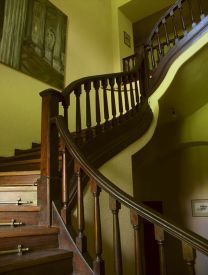The Royal Castle of Săvârşin, Romania
Royal Romanian Christmas, Savarsin 2010
HM Queen Anne of Romania accompanied by Crown Princess Margarita, Prince Radu and her grandson Prince Nicholas welcomed local folk dancers for a performance outside the Romanian Royal Family's Savarsin Castle.
A few years ago this beautiful property was returned to HM King Michael by the Romanian government.
©HRH Prince Radu of Romania
HM Queen Anne of Romania accompanied by Crown Princess Margarita, Prince Radu and her grandson Prince Nicholas welcomed local folk dancers for a performance outside the Romanian Royal Family's Savarsin Castle.
A few years ago this beautiful property was returned to HM King Michael by the Romanian government.
©HRH Prince Radu of Romania
Lake on the royal castle domain (Savarsin)
Lake on the royal castle domain (Savarsin)
The Royal Castle of Săvârşin, Arad County, Transylvania, Romania, is the country seat of King Michael I of Romania.
At Săvârşin there was a hunting area and the location was a hunting manor, built in 1650. Brunswick family received the domain as a donation from the Austrian Emperor. Around 1800, Franz Brunswick's daughter, Iulia, married Count Forray Andras and the castle belonged to the Forray family until sometime in the 19th century. Franz Brunswick had another daughter, Tereza Brunswick, and a very good friend: Ludwig van Beethoven. The German composer came at Săvârşin in 1807 and fell in love with Tereza. The story appears in the Săvârşin village monograph including the fact that the famous composer dedicated 'Apassionata' to Franz Brunswick and 'Sonata no. 78' to his beloved Tereza.
Săvârşin Castle was built between 1650 and 1680, as a manor. Subsequently, the Empress Maria Theresa donated the domain to Count Eidenchpacher. In 1780, the entire property came into possession of Count Forray. On June 9, 1784, here was kidnapped Viscount Forray Andras Sr. by the haiduci (outlaws) led by Petre Baciu. The head of the county administration was released only after the Austrian Emperor Josef II satisfied the claims of the outlaws. On November 9, 1784, the castle was burnt during the uprising of Horea, Cloşca and Crişan. Returned from exile, Count Forray managed to restore much of the building. During the Revolution of 1848, the castle was burned and destroyed.
It subsequently became the property Count Nadajdy. One of the count daughters married with a son of Karol Hunyadi. In 1860, Nadajdy and Hunyadi have employed an Austrian architect who added a new storey and designed the side wings in Neo-Classical style, works finished in 1870. In 1941, the sole heir of the family, Hunyadi Ferenc, became Minister of Interior of Hungary. How the law forbade him to own properties in Romania, in May he made a deal with Baron Ioan Mocsony-Stârcea, grand hunting master of the Royal Court. Castle of the Săvârşin came thus in possession of Mocsony, in exchange for a property which he owned near Budapest. Between 1941-1943, there were performed modernization works.
According to Wikipedia, in 1925, when he was 16 yo, Ionel Stârcea (or Styrcea) was adopted by Austrian baron Anton Mocsonyi of Foen, a family friend who had no direct descendants. On the death of Baron, Ioan Mocioni-Stârcea have received the properties and its title, becoming the owner of a large area on Mureş Valley, between Deva and Arad (including Săvârşin and Bulci castles). He became one of the richest men in Romania.
Queen Elena of Romania fell in love at first sight of the castle. As a gesture of appreciation towards the Royal Family, Baron Mocsony-Stârcea, who was also the godfather of King Michael I, gave him the palace as a gift (according other sources, the Queen bought the castle). It was in 1943 and since then many of the most beautiful memories of King Michael are related to the castle in Săvârşin. On January 3, 1948, King Michael left Romania and the castle was nationalized.
While the castle was seized from the Royal Family by Communist authorities, in 2000, a Romanian court ordered that the building be restored to King Michael I. It entered in the touristic circuit since 2003 and was restored between 2005-2007. The King wants mostly to bring back to life the settlement through a tradition and local arts encouraging programme. Apart from founding workshops, an exhibition space (the Yellow House), and a restaurant, the Royal House wishes to transform the park according to the Highgrove Garden, as arranged by Prince Charles. The works are done on a collaboration basis with a number of London's Writtle College representatives, who thought of developing an eco-horticulture area, of modernizing the green houses, and inventorying the plant species and fauna in the Săvârşin Park.
The dendrological park (arboretum) around the castle was established by Viscount Forray Istvan, who called a renowned landscape architect from the Empire in order to create the park by the year 1857. This park covers an area of 6.5 hectares and contains several rare species of trees and shrubs, monuments of nature, and a beautiful lake.











.JPG)
